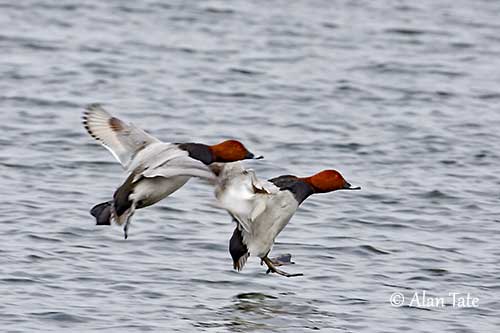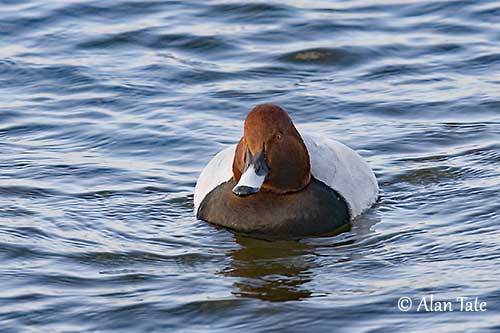
Fr: Fuligule milouin
Ang: Common Pochard
All: Tafelente
Esp: Porrón Europeo
Ita: Moriglione
Nd: Tafeleend
Sd: brunand
Photographers:
Didier Buysse
Vision d’Oiseaux
Otto Plantema
Trips around the world
Alan & Ann Tate
AA Bird Photography
Text by Nicole Bouglouan
Sources:
HANDBOOK OF THE BIRDS OF THE WORLD vol 1 by Josep del Hoyo-Andrew Elliot-Jordi Sargatal - Lynx Edicions - ISBN: 8487334105
THE COMPLETE BOOK OF BRITISH BIRDS – Written by “Royal Society for the Protection of Birds” experts - Préface de Magnus Magnusson - Michael Cady- Rob Hume Editors - ISBN: 0749509112
THE HANDBOOK OF BIRD IDENTIFICATION FOR EUROPE AND THE WESTERN PALEARCTIC by Mark Beaman, Steve Madge - C. Helm - ISBN: 0713639601
GUIDE DES CANARDS, DES OIES ET DES CYGNES – de Steve Madge - Delachaux et Niestlé - ISBN: 2603013769
ENCYCLOPEDIE DES OISEAUX DE FRANCE ET D’EUROPE – de Peter Hayman et Rob Hume - Flammarion – ISBN : 2082009920
BIRDS OF THE MIDDLE EAST by R.F. Porter, S. Christensen, P Schiermacker-Ansen C.Helm - ISBN: 0713670169
The food and feeding-habits of the Pochard, Aythya ferina
Northern Ireland Priority Species
What Bird-The ultimate Bird Guide (Mitchell Waite)
THE AVIANWEB - Beauty of Birds (Sibylle Faye)
Wikipedia, the free encyclopaedia
Common Pochard
Aythya ferina
Anseriformes Order – Anatidae Family
INTRODUCTION:
The Common Pochard is a medium-sized diving duck with stocky body and relatively short tail. It breeds in most parts of temperate and northern Europe into Asia, and migrates after breeding to spend the winter in S and W Europe.
It feeds on seeds, roots and other plant material, and also takes small invertebrates by diving and dabbling. It breeds in marshes and around lakes with open water but with fringing and emergent vegetation around the edges. During winter, it frequents more open lakes, slow-moving rivers and sheltered bays and estuaries.
The Common Pochard has decreasing population. The species is affected by habitat loss, especially in lowland marshes and fish ponds, caused by drainage of these habitats for agriculture expansion. Predation by both native and introduced mammals, hunting pressure, disturbance and diseases are important threats too.
The Common Pochard is currently listed as Vulnerable.

DESCRIPTION OF THE BIRD:
Biometrics:
Length: 42-49 cm
Wingspan: 72-82 cm
Weight: M: 585-1240 g – F: 465-1090 g
The Common Pochard adult male in breeding plumage has blackish upper mantle, rump, tail and breast. Rest of body is pale grey with slightly darker vermiculations. On the upperwing, the coverts are dark grey whereas the flight-feathers are paler, mostly silver-grey with darker tips to primaries and secondaries. The underwing is whitish.
The head is rufous-chestnut. The profile is slightly concave, leading to peaked crown.
The bill is dark grey with broad, pale grey subterminal band and black nail. The eyes are bright orange-red. Legs and webbed feet are bluish grey.
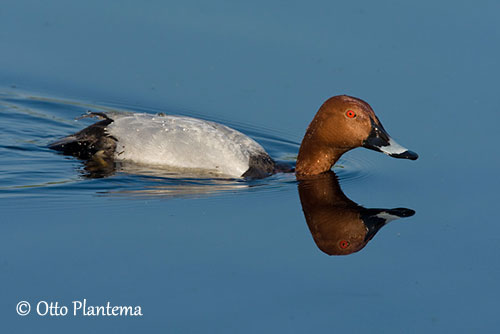
The male in eclipse resembles female but it has greyer body with contrasting dark breast.
The adult female has mainly greyish-brown body plumage, darker on the upperparts. The wings are browner than in male. The head is dull brown. We can see a narrow, pale grey eyestripe. Lores, cheeks and throat are pale grey too, but with variable pattern.
The bill is dull grey to blackish, with broad, pale grey subterminal band and broad black tip. The eyes are brown. Legs and webbed feet are greyish.
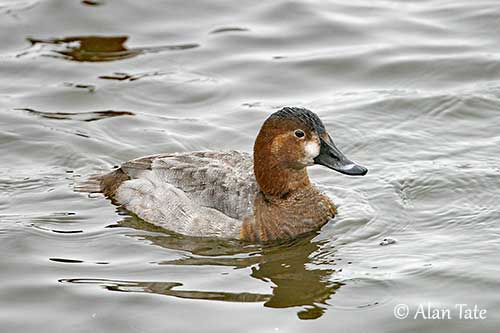
The juvenile resembles adult female but the underparts are more mottled. The head is duller and the eyestripe is absent. The body plumage shows pale vermiculations, whereas mantle, breast and flanks are dark grey.
The young female has uniformly grey-brown mantle, olive fringes to scapulars and tertials, and greyish-brown wing-coverts.
RANGE:
The Common Pochard breeds in W Europe, E through C Asia to SC Siberia and N China.
It winters S to N and E Africa, India and S and E Asia.
The species is a rare visitor to Aleutian Islands and Pribilof Islands, and it is rarely recorded in other parts of Alaska.
HABITAT:
The Common Pochard breeds around freshwater lakes and ponds with open water, but also with dense cover of fringing and emergent vegetation near the shores.
Outside this period, it can be seen on more open lakes and reservoirs, slow-flowing rivers, and sometimes in sheltered bays and estuaries.
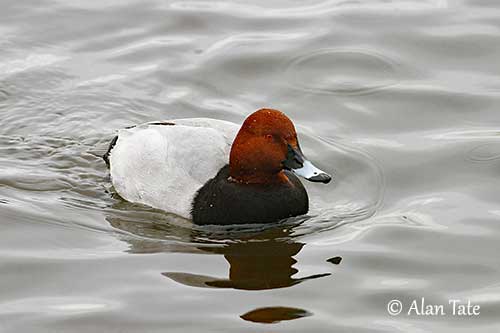
CALLS AND SONGS: SOUNDS BY XENO-CANTO
The Common Pochard male is usually silent, but during the breeding season, it may produce repeated, soft, low whistling “pee” and hoarse wheezing notes.
The female produces rough, harsh, growled “kraa-kraa” when flushed. She also utters some raspy, simple calls.
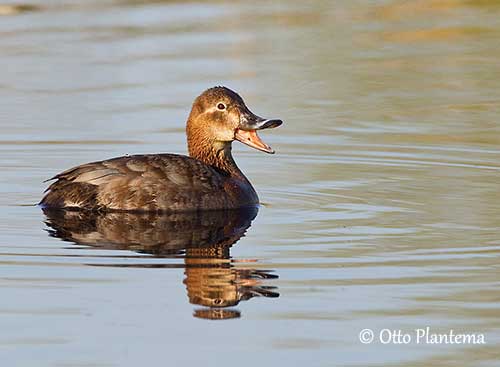
BEHAVIOUR IN THE WILD:
The Common Pochard is a gregarious species often seen in small groups or large flocks.
It feeds primarily on plant material such as roots, seeds and green parts of aquatic plants (grasses, sedges and other plant species). It also consumes small invertebrates including aquatic insects (adults and larvae), molluscs, crustaceans and worms. It may occasionally take amphibians and small fish.
It dives to 1-2,5 metres deep and also performs upending and dabbling at water surface. On the shore, it filters the mud to find invertebrates.
The Common Pochard is mainly active at dusk and in the early morning, and sometimes at night too. During the day, they rest and sleep on water in large flocks, or in smaller groups on the shore.
Large flocks can be seen during the post-breeding moult.
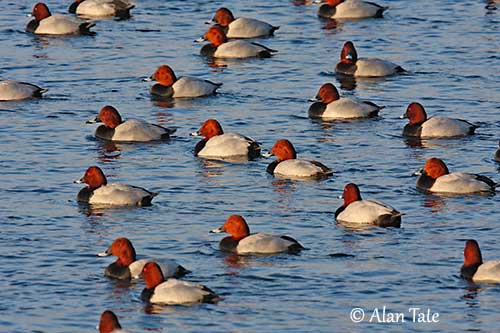
The pair forms in late winter and in spring. They are monogamous for the season, and the mates remain together until the first or second week of incubation. They breed in single pairs or loose groups. The nest is a shallow depression on the ground, hidden among the vegetation, less than ten metres from water.
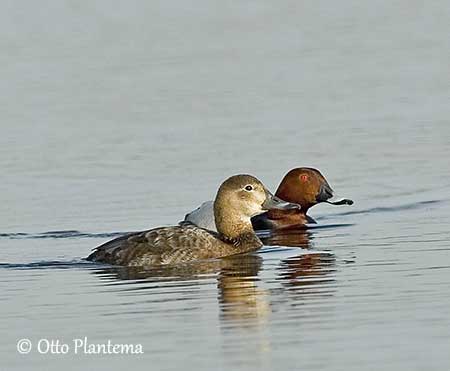
The Common Pochard is partly migratory and some of them may move over long distances. The males leave first while the female rears the brood. The W European populations are sedentary, but migratory groups often join them in winter.
The flight is strong and direct with powerful wingbeats. The flocks fly high in the air, in line or in V-shaped formation.
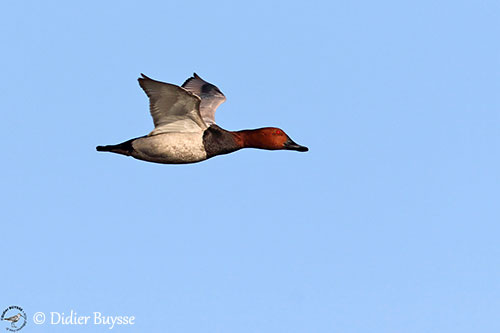
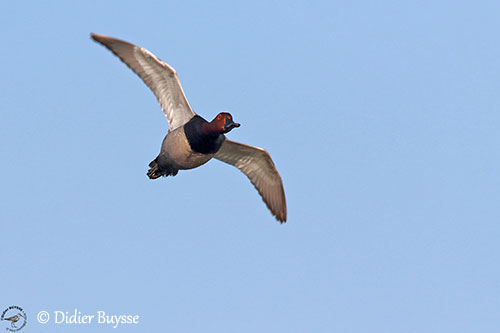
REPRODUCTION OF THIS SPECIES:
The breeding season occurs between mid-April and June, later in northern breeding range.
The Common Pochard nests on the ground in a shallow depression among the vegetation. It is made with grass, reed stems and leaves, and typically lined with down. The nest may be on the ground or partially over water.
The female lays 8-10 pale greenish-grey eggs. Some nests contain more than 15 eggs, as the result of parasitism which is common and may be intra or interspecific.
The female incubates during 24-28 days. At hatching, the chicks are brown above and yellow below. They fledge 50-55 days after hatching and the female leaves the nest-site to moult. However, the male sometimes remains with the female and both parents share the chick-rearing.
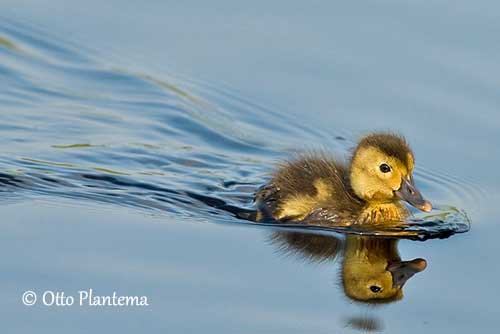
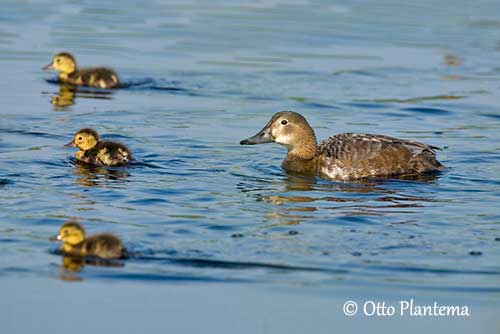
PROTECTION / THREATS / STATUS:
The Common Pochard is affected by the loss of the breeding habitat caused by drainage of wetlands for agriculture expansion. Predation at nest by minks, raccoons, foxes and wild boars involve the loss of the broods. Hunting pressure, urban development, ingestion of lead shot, drowning in freshwater fishing nets and diseases are important threats too.
The population was estimated to number 1,950,000/2,250,000 individuals in 2012. It is declining significantly throughout the large range.
The Common Pochard is currently listed as Vulnerable.
